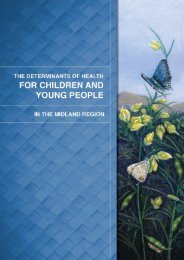Project SPLICE - Taranaki District Health Board
Project SPLICE - Taranaki District Health Board
Project SPLICE - Taranaki District Health Board
Create successful ePaper yourself
Turn your PDF publications into a flip-book with our unique Google optimized e-Paper software.
<strong>Project</strong> <strong>SPLICE</strong> FINAL - February 2010<br />
Case, there are core functions that require management and coordination that occur at a<br />
central level. Whether these activities are grouped across the region or are kept within<br />
<strong>Taranaki</strong> is a subsequent discussion. The Model of Care presented here outlines the<br />
approach and this can be configured either as a standalone unit within <strong>Taranaki</strong> DHB or in<br />
partnership with the other Midlands DHBs (Waikato, Tairawhiti and Lakes). Care referral and<br />
coordination will focus on five pertinent functions for older people and those with long term<br />
conditions:<br />
Table 3: Referral and Coordination functionality<br />
Function 6<br />
Description<br />
1. Triage Referrals for older people referred for disability support<br />
2. Short term<br />
care assessment &<br />
coordination:<br />
3. Non-complex<br />
assessment<br />
4. Non-complex<br />
coordination<br />
5. Administration<br />
and interface with<br />
national payment<br />
systems<br />
Access point for clients requiring <strong>District</strong> Nursing and short term<br />
home care<br />
Of older people (or like age and interest) using the interRAI<br />
Contact tool, via telephone 7 by health professional assessors.<br />
Figure 2 illustrates the criteria for categorisation of disability<br />
support, using Levels I through to V 8 . Older people assessed<br />
within Levels I to III will be managed through the non-complex<br />
assessors within Care referral and coordination service and older<br />
people assessed as Levels IV or V will be passed to the care<br />
clusters for assessment by the care managers using the interRAI<br />
MDS-HC.<br />
Of older people (or like age and interest) assessed as requiring<br />
support (i.e. Home Care) through the interRAI Contact<br />
Assessment.<br />
For all older people 9 (or like age and interest) receiving disability<br />
support services (HBSS, Carer Support or ARC). The<br />
administration function will manage provider allocations,<br />
payment systems and databases.<br />
6<br />
7<br />
8<br />
9<br />
There are several other services that would lend themselves to inclusion in such an access point such as allied health<br />
and disease specific services. However, given the Midland Business Case developments, it is prudent to await the<br />
decisions around this proposal prior to investing heavily in further consolidation<br />
In those instances when a telephone based assessment is inappropriate, such as when the older person has a hearing<br />
loss, or when a face to face assessment is a more culturally appropriate option, the client will be passed to the care<br />
manager based within the clusters.<br />
This leveling system has been developed from the IN-TOUCH programme, a partnership between ten DHBs, Nurse<br />
Maude and The University of Auckland and is discrete from the Support Needs Level and interRAI Contact Acuity Scale.<br />
It is currently in operation in Multiple DHBs.<br />
Whether non-complex, assessed through the interRAI Contact assessment through the care referral and coordination<br />
service or complex assessed using the MDS-HC by the Care Cluster based Care Managers.<br />
22 | P a g e

















